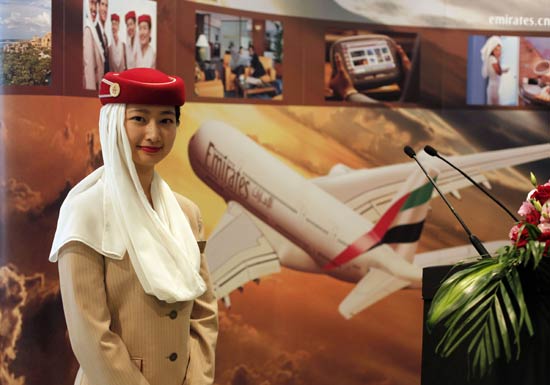Economy
CAAC encourages carriers to change
Updated: 2011-05-12 09:25
By Xin Dingding (China Daily)
|
 A flight attendant awaits the arrival of Emirates Airlines' first A380 at Pudong International Airport in Shanghai. The Civil Aviation Administration of China said it will take measures to encourage carriers to explore the international market. [Photo / China Daily] |
Nation's aviation authority suggests airlines should restructure fleets
BEIJING - China's civil aviation authority on Wednesday encouraged the country's airlines to add more wide-body jets to their fleets.
The Civil Aviation Administration of China (CAAC) also said it will take measures to encourage carriers to explore the international market.
Li Jiaxiang, head of CAAC, told the China Civil Aviation Development Forum that of the country's air transport fleet of 2,600 planes, only some 150 are wide-body airliners. The majority, or 80.8 percent, are single-aisle planes, while another 150 are regional aircraft, which carry fewer than 100 passengers.
"Some airlines even regarded wide-body planes as a burden. But with flight time slots at major airports becoming scarce and the globalization (of travel), wide-body jets will be very useful," said Li.
He said that as the nation's high-speed railways push to dominate the lucrative domestic transport market, and the increasing number of Chinese traveling overseas is providing airlines with fresh opportunities.
| ||||
Among the limited capacity allocated to international routes, airlines have focused on Japan, South Korea and Southeast Asia. Their concentration on a few lucrative international routes has undercut the strength of China's air transport industry as a whole, he said.
"We observed that in the case of countries with flights to China, usually only one airline is designated to operate flights on a certain route. But in our case, several airlines are crammed onto a few routes, which offsets the country's competitiveness. The government will direct them to integrate capacities and make alliances," said Li.
He said the government will encourage both large and regional airlines to engage in cooperation and consolidation to eventually achieve the goal of having two or three large competitive airlines.
Li also noted that some airlines were granted rights to operate flights on routes that they did not fully exploit or simply wasted. "The CAAC will regularly publicize the carriers' use of traffic rights and retrieve the rights from those who have not made good use of them," he said.
By the end of 2010, China had signed bilateral air transport pacts with 112 countries and regions. However, Chinese airlines opened scheduled flights only to 54 countries. Meanwhile, on some international routes, the number of flights operated by domestic airlines is insufficient.
On routes between China and the United States in 2010, US airlines opened 34 scheduled passenger and cargo flights and offered 199 flights each week, but Chinese carriers opened only 15 scheduled flights and offered 140 flights each week.
Li said that China's major carriers should also note the potential of low-cost airlines and offer differentiated services.
Kong Dong, chairman of Air China Ltd, said at the forum that the national carrier's fleet will add 10 more wide-body jets this year: four Boeing 777s and six Airbus 330s. "The fact that we did not expand the fleet during the past two years has made us lose some opportunities," said Kong.
"With the new jets, Air China will operate flights to Africa and South America, and add flights to Los Angeles. Before that, we will also open new flights to Europe, such as the recently added flights to Milan and Dusseldorf."
Specials

Sino-US Dialogue
China and the US hold the third round of the Strategic and Economic Dialogue from May 9-10 in Washington.

New wave
Coastal city banks on marine sector to ride next stage of economic development

V-Day parade
A military parade marking the 66th anniversary of the Soviet victory over Nazi.



